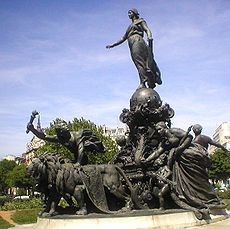
Back ميدان لاناسيون (باريس) Arabic Place de la Nation Catalan Place de la Nation Czech Place de la Nation German Plaza de la Nación Spanish Nazioaren plaza (Paris) Basque Place de la Nation Finnish Place de la Nation (Paris) French Place de la Nation ID Place de la Nation Italian
This article needs additional citations for verification. (January 2017) |
 The Triumph of the Republic by Aimé-Jules Dalou | |
| Length | 252 m (827 ft) |
|---|---|
| Width | 252 m (827 ft) (circular with diameter = 252 m) |
| Arrondissement | 11th, 12th |
| Quarter | Sainte-Marguerite . Picpus |
| Coordinates | 48°50′54″N 2°23′45″E / 48.84833°N 2.39583°E |
| From | Rue du Faubourg Saint-Antoine |
| To | Avenue du Trône |
| Construction | |
| Completion | Already present on the Delagrive plan in 1728 |
| Denomination | 2 July 1880 |
The Place de la Nation (French pronunciation: [plas də la nasjɔ̃]; formerly the Place du Trône [- tʁon], subsequently the Place du Trône-Renversé [- ʁɑ̃vɛʁse] during the French Revolution) is a circle on the eastern side of Paris, between the Place de la Bastille and the Bois de Vincennes, on the border of the 11th and 12th arrondissements. Widely known for having the most active guillotines during the Revolution, the square acquired its current name on Bastille Day, 14 July 1880, under the Third Republic.
The square includes a large bronze sculpture by Aimé-Jules Dalou, the Triumph of the Republic, depicting the personification of France, Marianne, and is encircled by shops and a flower garden. It is served by the Paris Metro station Nation.
